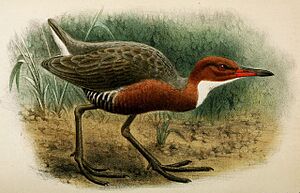White-throated rail facts for kids
Quick facts for kids White-throated rail |
|
|---|---|
 |
|
| D. c. cuvieri, Ranomafana National Park | |
| Conservation status | |
| Scientific classification | |
| Genus: |
Dryolimnas
|
| Species: |
cuvieri
|
The white-throated rail (Dryolimnas cuvieri) is a special kind of bird that belongs to the Rallidae family. It's also known as Cuvier's rail. These birds are known for being quite unique, especially because some of them have lost the ability to fly!
Where Do White-Throated Rails Live?
You can find white-throated rails in several places around the Indian Ocean. They live on islands like the Comoros, Madagascar, Mayotte, and the Seychelles. These birds like to live in warm, wet places. Their favorite homes are forests that are wet and warm, and also mangrove forests near the coast.
Meet the Rail Family: Different Types
The white-throated rail has different groups, called subspecies, that live in various places.
- The main group, called the nominate subspecies, lives in Madagascar.
- There's a very special group called the Aldabra rail (Dryolimnas (cuvieri) aldabranus). These birds live on Aldabra island and cannot fly at all! They are believed to be the last flightless birds left in the Indian Ocean.
- Sadly, another group, the Assumption rail (D. c. Abbott), used to live on Assumption Island. These birds could barely fly. They became extinct in the early 1900s because new animals were brought to their island. These new animals were predators, meaning they hunted the rails.
Amazing Evolution: A Bird's Comeback Story
Scientists have found old bones of another flightless rail on Aldabra. This bird was very similar to the Aldabra rail we see today. However, it died out a long time ago during the Pleistocene period. This happened because sea levels rose and covered the island.
But here's the amazing part! After the island reappeared from the water, white-throated rails came back to Aldabra. Over time, these new birds also lost their ability to fly, just like the ones before them. They evolved in a very similar way! This is a rare event called iterative evolution. It means a group of animals disappears from an area, but then new animals from the same original group come back and evolve in the same way again. It's like nature hitting the "redo" button!
Today, the white-throated rail is the only living member of its group, called Dryolimnas.



